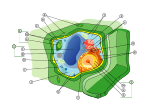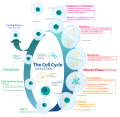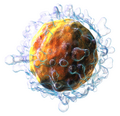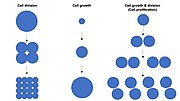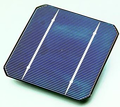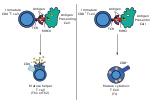S cells are cells which release secretin, found in the jejunum and duodenum. They are stimulated by a drop in pH to 4 or below in the small intestine's...
2 KB (161 words) - 22:51, 13 September 2024
Sickle cell disease (SCD), also simply called sickle cell, is a group of hemoglobin-related blood disorders that are typically inherited. The most common...
139 KB (14,974 words) - 23:37, 23 November 2024
The cell cycle, or cell-division cycle, is the sequential series of events that take place in a cell that causes it to divide into two daughter cells. These...
78 KB (9,093 words) - 03:11, 11 November 2024
Photoresistor (redirect from CdS cell)
photoresistor (also known as a light-dependent resistor, LDR, or photo-conductive cell) is a passive component that decreases in resistance as a result of increasing...
7 KB (720 words) - 00:56, 12 November 2024
The list of human cell types provides an enumeration and description of the various specialized cells found within the human body, highlighting their...
35 KB (1,768 words) - 22:54, 6 October 2024
S phase (Synthesis phase) is the phase of the cell cycle in which DNA is replicated, occurring between G1 phase and G2 phase. Since accurate duplication...
15 KB (1,681 words) - 15:45, 29 October 2023
Enteroendocrine cells are specialized cells of the gastrointestinal tract and pancreas with endocrine function. They produce gastrointestinal hormones...
17 KB (1,686 words) - 13:16, 10 March 2024
cycle in which the cell grows and replicates its chromosome(s) before dividing. In eukaryotes, there are two distinct types of cell division: a vegetative...
41 KB (4,735 words) - 04:03, 18 November 2024
The cell is the basic structural and functional unit of all forms of life. Every cell consists of cytoplasm enclosed within a membrane; many cells contain...
60 KB (6,269 words) - 17:14, 21 November 2024
plants. Bacterial cell walls contain peptidoglycan, while archaeal cell walls vary in composition, potentially consisting of glycoprotein S-layers, pseudopeptidoglycan...
43 KB (4,765 words) - 05:01, 2 November 2024
A fuel cell is an electrochemical cell that converts the chemical energy of a fuel (often hydrogen) and an oxidizing agent (often oxygen) into electricity...
140 KB (14,516 words) - 22:38, 23 November 2024
Flame cells function like a kidney, removing waste materials. Bundles of flame cells are called protonephridia. The flame cell has a nucleated cell body...
2 KB (235 words) - 13:15, 4 March 2024
Mitosis (redirect from Mitotic cell division)
rise to genetically identical cells in which the total number of chromosomes is maintained. Mitosis is preceded by the S phase of interphase (during which...
71 KB (7,317 words) - 19:25, 22 November 2024
S. Cellular served, after Chicago. In October 2008, U.S. Cellular launched Mobile Broadband, a service enabling customers to access data on its cell phones...
20 KB (1,961 words) - 17:04, 23 November 2024
Enterochromaffin-like cell Gastric chief cell Parietal cell Foveolar cell Intestinal enteroendocrine cells S cell Delta cell Cholecystokinin Enterochromaffin cell Goblet...
6 KB (433 words) - 00:39, 25 November 2024
multicellular organisms, stem cells are undifferentiated or partially differentiated cells that can change into various types of cells and proliferate indefinitely...
98 KB (11,480 words) - 15:46, 20 November 2024
of a T-cell receptor (TCR) on their cell surface. T cells are born from hematopoietic stem cells, found in the bone marrow. Developing T cells then migrate...
71 KB (9,061 words) - 19:16, 16 November 2024
Cell–cell interaction refers to the direct interactions between cell surfaces that play a crucial role in the development and function of multicellular...
17 KB (2,221 words) - 05:01, 2 November 2024
of cell proliferation, where a cell, known as the mother cell, grows and divides to produce two daughter cells. Importantly, cell growth and cell division...
37 KB (4,869 words) - 09:19, 17 May 2024
Cell cycle checkpoints are control mechanisms in the eukaryotic cell cycle which ensure its proper progression. Each checkpoint serves as a potential termination...
34 KB (4,581 words) - 11:50, 4 April 2024
Basal-cell carcinoma (BCC), also known as basal-cell cancer, basalioma or rodent ulcer, is the most common type of skin cancer. It often appears as a painless...
55 KB (5,426 words) - 04:15, 2 November 2024
Squamous-cell carcinoma (SCC), also known as epidermoid carcinoma, comprises a number of different types of cancer that begin in squamous cells. These cells form...
22 KB (2,312 words) - 15:17, 8 November 2024
G1 phase (redirect from G1 phase of the cell cycle)
the cell moves into the S phase of interphase. Around 30 to 40 percent of cell cycle time is spent in the G1 phase. G1 phase together with the S phase...
10 KB (1,234 words) - 17:32, 25 November 2023
Natural killer cells, also known as NK cells, are a type of cytotoxic lymphocyte critical to the innate immune system. They are a kind of large granular...
75 KB (9,227 words) - 23:32, 16 October 2024
B cells, also known as B lymphocytes, are a type of white blood cell of the lymphocyte subtype. They function in the humoral immunity component of the...
32 KB (3,748 words) - 21:03, 6 November 2024
A solar cell or photovoltaic cell (PV cell) is an electronic device that converts the energy of light directly into electricity by means of the photovoltaic...
150 KB (17,095 words) - 07:35, 19 November 2024
A dendritic cell (DC) is an antigen-presenting cell (also known as an accessory cell) of the mammalian immune system. A DC's main function is to process...
34 KB (3,972 words) - 15:36, 25 August 2024
Mast cell activation syndrome (MCAS) is a term referring to one of two types of mast cell activation disorder (MCAD); the other type is idiopathic MCAD...
23 KB (2,424 words) - 22:49, 22 November 2024
A cytotoxic T cell (also known as TC, cytotoxic T lymphocyte, CTL, T-killer cell, cytolytic T cell, CD8+ T-cell or killer T cell) is a T lymphocyte (a...
31 KB (3,852 words) - 03:38, 17 November 2024










